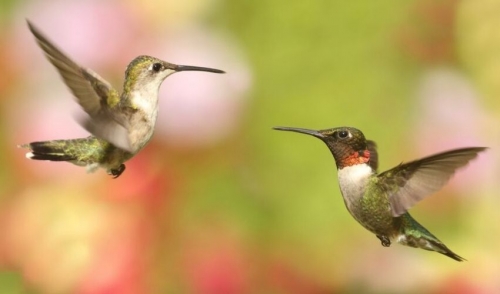
Hummingbird Migration Schedule
Hummingbirds are some of the most desirable and sought-after backyard birds, and many birders eagerly watch the hummingbird migration schedule to be prepared for these flying jewels. Understanding when hummingbirds migrate can help every birder be ready to welcome and nourish even the smallest birds with blooming flowers, safe shelter, and feeders filled with fresh, sweet nectar.
About Hummingbird Migration
Of the more than 325 hummingbird species in the world, most do not migrate at all because their rich, tropical habitats in the Caribbean, central America, and South America serve their needs year-round. More northerly species, however, including most hummingbirds seen in the United States and Canada, do migrate each spring and fall. Depending on the species, a tiny hummingbird might travel hundreds or thousands of miles between its breeding and non-breeding ranges, flying during the day and keeping a keen eye out for food and shelter along the way. While it is astonishing that these small birds successfully make such incredible migrations, even more amazing is their precise migration schedule, when hummingbirds may arrive and depart on nearly the same days each year. How do they do it?
How Hummingbirds Tell Time
Hummingbirds don’t use watches, calendars, or text alerts to let them know it is time to migrate, yet year after year birders and ornithologists alike are astounded when these birds may appear and disappear on almost exactly the same dates. The overall amount of daylight each day, as well as the angle of the sun, are the biggest, most forceful clues hummingbirds use to schedule their migrations, and those annual cycles drive when hummingbirds migrate. Smaller factors also influence the exact dates of hummingbird migration, including local food availability and climate patterns. Older, more experienced hummingbirds typically migrate earlier than juvenile birds, and males will migrate ahead of females in order to claim territories to attract the best mates. Of course, hummingbirds that migrate much greater distances will also be on the move before hummers with shorter migration routes.
When Hummingbirds Migrate
Because of their different ranges, migration routes, and habitat needs, different hummingbirds will migrate at slightly different times. Hummingbirds with the longest migration routes may begin heading north in the spring as early as mid-February or early March, and they will arrive on their breeding grounds in May or early June. After the breeding season ends, these same birds will get a head start on migration by leaving as early as late July in order to head south again.
On the other hand, hummingbirds with less demanding migration patterns may not begin their northern spring journeys until April or even early May, especially if they don’t have far to travel. These birds might stay in their breeding range for longer periods, and may not be heading south again until late August or early September, and they will arrive in their winter range by mid-October or early November.
Tracking Your Hummingbird Migration Schedule
Many birders enjoy creating their own hummingbird calendars by tracking migration schedules from year-to-year. Simply take a notebook or journal and note when hummingbirds are first spotted, including the species and gender if possible. Including other hummingbird-friendly details can also help create a reliable schedule, such as listing when the best hummingbird flowers begin to bloom, what the spring and fall weather has been like, and whether or not other migrating birds are on the move. The more details that are included, the more accurate the calendar will be, and the more helpful it will be in planning how to best attract the earliest and latest hummingbirds each year.
Hummingbirds can be some of the most predictable backyard birds, and once you understand their migration schedule, you can be better prepared to meet their needs and attract these glorious visitors from early spring through late fall.
